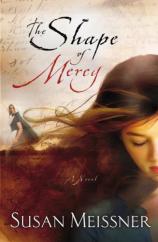The Shape of Mercy
Review
The Shape of Mercy
Susan Meissner has grown tremendously as a writer, and nowhere is this more evident than in her ninth novel, THE SHAPE OF MERCY, a grab-the-hanky inspirational tale of one young woman’s search for identity and meaning. It’s a beautifully told story, full of contemporary yearnings, historical intrigue and romance.
Sophomore college student Lauren Durough feels the pressure of being the only child of a wealthy, driven father who --- unlike the stereotype you’d expect in the typical inspirational novel --- is also loving, involved and interested. But Lauren wants to prove she can earn her spending money herself rather than just taking cash from her family. She answers a handwritten ad posted on a college bulletin board: “Wanted --- Literary Assistant for transcription project.” Lauren is hired by 83-year-old Abigail Boyles to transcribe a 300-year-old diary written by Mercy Hayworth, Abigail’s cousin eight times removed, who was named as a witch in the Salem witch trials in the late 1600s.
As she did in BLUE HEART BLESSED, Meissner uses the device of journal entries throughout her novel, but this time the entries are four centuries old. As Lauren works with Abigail on the transcription, she is caught up in the life of Mercy and bigger questions about moral law, hysterical fears and their effect on society, social intolerance and empowerment. All are timely issues for contemporary readers as well.
I particularly liked this exchange between Lauren and her father, in which Lauren is confused that anyone would believe false accusations about good women during the Salem witch trials. Her father tells her:
“How does anybody convince anybody else of anything? You catch them at a weak moment, when they’re feeling alone or afraid, and you offer them the security of solidarity. Advertising execs use this tactic all the time: Buy this and be like everyone else. Don’t buy it and be the loser no one respects.”
“So I guess the key is to never let yourself feel alone or afraid.”
“No,” he responded. “The key is to never let someone else tell you what to think.”
As Lauren works on personal issues of identity, she discovers some prejudices she harbors about others that catch her off-guard, especially in her attraction to Raul, her cousin’s handsome roommate. Lauren also gleans new understandings about herself as she reads about Mercy’s life and becomes involved with the elderly Abigail, who has secrets and identity issues of her own. These secrets, and Mercy’s final choices, influence the choices Lauren makes about her life. In this way, Meissner subtly points out the value of intergenerational interaction and the importance of learning from events in history, especially in times of national fears or uncertainty.
Meissner’s prose is lovely throughout, especially in her descriptions. Mercy’s diary pages are “the color of toast” in some places and, in others, “the color of wet ashes.” The letters “looked like whispers, if whispers had form.” Meissner competently handles the mechanics of her fiction so the reader is drawn into a seamlessly told story. The three romance elements are crucial to the plot but support the main themes rather than becoming the main themes themselves. The resolution guarantees to wring tears from the most stoic readers.
Although this novel is classified as contemporary, THE SHAPE OF MERCY should appeal to both historical fiction and romance readers as well. If you aren’t familiar with Meissner’s work, this is a great place to start.
Reviewed by Cindy Crosby on September 16, 2008





